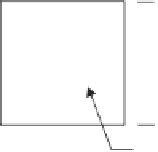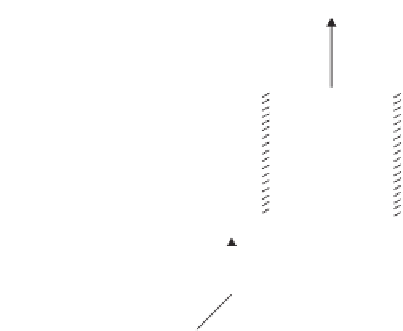Environmental Engineering Reference
In-Depth Information
coefficients
D
ay
and
k
ay
have similar functional relationships
with respect to soil suction.
The measurement of the air coefficient of permeability in a
triaxial cell is an application of one-dimensional steady-state
air flow. The air coefficient of permeability is assumed to be
constant throughout the soil specimen. The air flow equation
is reduced to a linear differential equation by neglecting
changes in the air coefficient of permeability with respect to
location:
dJ
ay
dy
J
ay
+
dy
dy
J
ay
Soil
element of
thickness
dz
∂
2
u
a
dy
2
y
=
0
(9.53)
dx
x
The pore-air pressure distribution in the
y
-direction is
obtained by integrating Eq. 9.53 two times:
z
Figure 9.8
One-dimensional steady-state air flow through unsat-
urated soil element.
u
a
=
C
1
y
+
C
2
(9.54)
where:
The net mass rate of air flow can be written as
dJ
ay
dy
dx dy dz
C
1
,C
2
=
constants of integration related to the boundary
conditions
=
0
(9.50)
y
=
distance in the
y-
direction.
Substituting Fick's law for the mass rate of flow into the
above equation yields a nonlinear differential equation:
Figure 9.34 illustrates the pore-air pressure distribution
within a soil specimen during an air permeability test. The
air pressures at both ends of the specimen (i.e.,
u
a
=
D
ay
(u
a
−
d
{−
u
w
)
du
a
/
dy
}
u
ab
at
=
0
(9.51)
y
h
s
) are the boundary con-
ditions. Substituting the boundary conditions into the flow
equation results in a linear equation for the pore-air pressure
along the soil specimen [i.e.,
u
a
=
=
0
.
0 and
u
a
=
u
at
=
0
.
0at
y
=
dy
where:
(
1
−
y/h
s
)u
ab
]
.
D
ay
(u
a
−
u
w
)
=
air coefficient of transmission as a func-
tion of matric suction,
9.6.2 Two-Dimensional Steady-State Air Flow
Two-dimensional steady-state air flow is first formulated for
the case where the air coefficient of transmission is a func-
tion of matric suction. The air coefficients of transmission in
the
x
- and
y
-directions,
D
ax
and
D
ay
, are related to matric
du
a
/dy
=
pore-air pressure gradient in the
y-
direc-
tion,
u
a
=
pore-air pressure, and
u
w
=
pore-water pressure.
suction using the same transmission function,
D
a
u
a
−
u
w
.
The
D
ax
/D
ay
ratio is assumed to be constant at any point
within the soil mass. An element of soil subjected to two-
dimensional air flow is shown in Fig. 9.9. Satisfying conti-
nuity for steady-state flow yields the following equation:
J
ax
+
The coefficient of transmission
D
ay
(u
a
−
u
w
)
will be writ-
ten as
D
ay
for simplicity, and it must be remembered that
the soil property is a function of soil suction. The spatial
variation of the variable,
D
ay
, results in nonlinearity in the
mass flow equation:
J
ax
dy dz
∂J
ax
∂x
dD
ay
dy
∂
2
u
a
dy
2
du
a
dy
=
dx
−
D
ay
+
0
(9.52)
J
ay
+
J
ay
dx dz
∂J
ay
∂y
+
dy
−
=
0
(9.55)
where:
dD
ay
/
dy
=
change in the air coefficient of transmission
in the
y-
direction.
where:
J
ax
=
mass rate of air flowing across a unit area of the
soil in the
x
-direction.
Equation 9.52 describes the pore-air pressure distribution
in the soil mass in the
y-
direction. The second term in the
equation accounts for the spatial variation in the coefficient
of transmission. The coefficient of transmission is obtained
by dividing the air coefficient of permeability
k
ay
by gravi-
tational acceleration (i.e.,
D
ay
=
Rearranging Eq. 9.55 results in the following equation:
∂J
ax
∂x
dx dy dz
∂J
ay
∂y
+
=
0
(9.56)
k
ay
/g
). In other words, the


















Search WWH ::

Custom Search